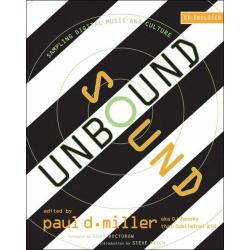This is a thick, encyclopedic collection of essays about aesthetics, by people who have a tendency to take structural forms (pop songs, soul music, genre literature, rock criticism, etc.) and mutate them into new forms of media.
From textbook-style packaging and accompanying CD, it may seem like a dry read, but it isn't. This is probably the most useful music journalism manifesto since Re/Search published its Industrial Handbook or Tape Delay came out in the mid-80s (with its writings by and interviews with Cave, Galas, etc.).
That's not to say everything in here makes total sense to the average reader. Author Jonathan Lethem does an avant-text loop of popular culture quotes that reminds me of similar experiments from the past few decades, but I don't find "The Ecstasy of Influence: A Plagiarism Mosaic" very satisfying for either instruction or entertainment. And certainly not more compelling than what Stewart Home and the Neoists wrote using the same ideology and technique in the late 80s. I didn't particularly need another interview with Moby either.
Here's a thought: Why did Leonard Cohen change from acoustic guitars to Casio keyboards for the "Various Positions" records and every album thereafter? As far as I know, no one has really discussed that at length with him, who like Tom Waits changed his entire style in context so that his content wouldn't be outdated. All of Moby's artistic decisions have been backed up by the milieu (whether in sales or by critical consensus), but Cohen's is always seen as tacky (due to him using cheap technology? That can't be it, can it? Because classicism by noise-fetishists would suck — unless of course, it always does come down to what gear you can afford, and how few 'ordinary' people actually listen to your music). And both have genre (hardcore and folk) backgrounds.
But that's criticizing something for what it isn't, and what this book is, is great. Cyberpunk novelist and "dead media researcher" Bruce Sterling does a remarkable job at discussing the merits of communicative forms that are archaic, and yet have tumescent value to the artist. (For example, the quipu, that was once "the nervous system of a major civilization," the Incas, and it was a very simple-seeming but extremely efficient "knot system" of historical record, a computer and calculator and day planner made out of colored threads.)
Sterling reminds us that cinema was a combination of a whole bunch of so-called "failed technologies" (such as Edison's kinetoscope, but also including the tachyscope, the vitagraph, the cinematographe, et al) as well as how "talkies" were not the only films in which people spoke (it just happened to become the popular form, for reasons of marketing and luck).
Dick Hebridge, who wrote one of the very best books about the roots of punk style and millennial fashion, "Subculture," contributes a brilliant meditation on dystopia as well, while one of my very favorite writers, Erik Davis (whose Led Zep 33 1/3 is head and shoulders above most of the other volumes in the series, and never fails to make every issue of Arthur Magazine a transcendent experience) examines the dense spiritual terrain between polyrhythm, technology and race: he knows heavy anthropological shit about the beliefs and practices of primitive cultures and what kind of future our own ideologies and art-forms will lead to, not to mention chatting up good stuff about funky cosmic music a couple decades ago, and his contribution could be considered the centerpiece of an already excellent book.
Simon Reynolds (whose book Blissed Out about rock and techno and spirituality broke the news about Nick Cave's fixation on the Bible, and the secret Situationism of many of your favorite underground artists) has a wonderful accompaniment to Davis's piece called "Renegade Academia."
From there, Brian Eno studies time and sound (and as I've always said, anything you can read of Eno will teach you at least one thing you've never even thought about before) through the history of bells, and Chuck D, Saul Williams, and Daniel Bernard Roumain take a more kinesthetic approach, keeping the text alive and crisp, and other writers like Joseph Lanza focus on the real reason misperceived "E-Z Listening" music was so compelling and collectable for "hi-fi" owners back in the days of early space age bachelor pads and swinging wreck rooms.
If the EMP Pop Con was strictly about dropping sound science, it would be in the form of this book. So buy it with Listen Again, the great new tome of Pop Con collected papers/presentations, and Brian Coleman's Check the Technique from last year, an update of his roots-of-rap Rakim Told Me, for the whole smear. That's a whole lot of great reading about listening, and as Mr. Davis might say, a whole lotta love.
